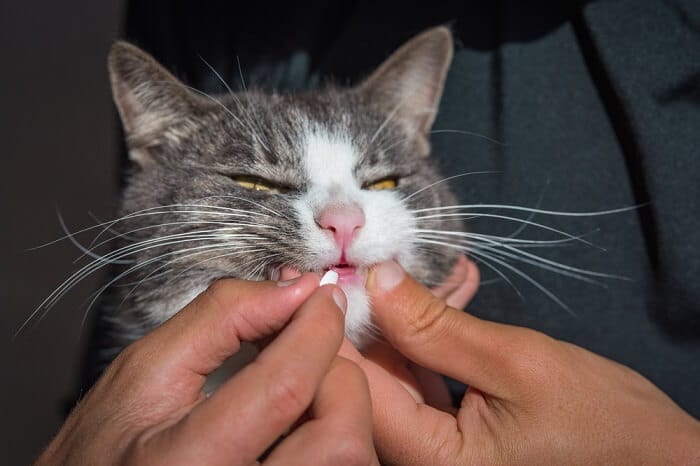Azithromycin is an antibiotic commonly used to treat certain bacterial infections in cats. In this article, you’ll learn more about what azithromycin does, conditions it may be indicated for, side effects to look out for, and some frequently asked questions.
Azithromycin For Cats Overview

About Azithromycin for Cats
Azithromycin, the common brand name for which is Zithromax, is classified as a macrolide antibiotic. It does have a fairly broad spectrum of action against many different kinds of bacteria.
Azithromycin is most often used in cats for upper respiratory infections, especially conditions that are chronic, recurrent, or refractory to other antibiotic therapies.
Azithromycin is listed as a Critically Important, Highest Priority antimicrobial for human medicine, making its indication for long term use in cats with chronic rhinosinusitis (chronic inflammation/infection of the nasal passages and sinuses) controversial, as long term use could cater to antimicrobial resistance to the drug. It is therefore may be used more in select cases and not as a first-line choice.
It reportedly has a quick effect against infections caused by Bartonella (the bacteria that causes “cat-scratch disease” in people) although clinically concerning infections in cats caused by Bartonella tend to be uncommon.
It is also thought to have some activity against certain protozoal microorganisms like Toxoplasma and Babesia as well, though better efficacy may be seen in combination with other appropriate medications.
Azithromycin is a bacteriostatic antibiotic, but this does not mean it is “weaker” than a bactericidal antibiotic like Clavamox. Bacteriostatic antibiotics do kill susceptible bacteria, they simply require a higher concentration to do so.
A 2018 study in Clinical Infectious Diseases comparing bacteriostatic and bactericidal antibiotics in people highlights this distinction. Researchers found that not only were bacteriostatic and bactericidal antibiotics about equivalent in efficacy most of the time, but that in cases where there was a difference, bacteriostatic antibiotics often appeared superior and more cost effective.
Unlike most antibiotics, azithromycin also has some anti-inflammatory and immune-modulating effects. Although these effects are not well understood in animals, these benefits likely contribute to improvements seen in cats with chronic rhinosinusitis and stomatitis (inflammation in the mouth).
Also while not very well understood in animals, azithromycin does have some promotility effects on the gastrointestinal tract in people (meaning it helps the GI tract move food along) and some of these effects have also been reported in dogs and cats.
What Does Azithromycin Do for Cats?
A unique characteristic of azithromycin is that it can remain in tissues much longer than other antibiotics.
Azithromycin is an effective antibiotic against most of the bacteria typically susceptible to it. Veterinarians commonly determine antibiotic use based on bacterial culture whenever possible or at least based on the likelihood of infectious organisms present, and the body system affected.
As with most antibiotics, azithromycin has good levels of efficacy against certain bacteria, while others may be resistant or just not susceptible to it.
For example, an upper respiratory infection in a cat caused by the bacteria Bordetella, or uveitis (inflammation in the eye) caused by Bartonella, will typically be susceptible, but it has no effect against Chlamydophila felis that causes conjunctivitis in cats, or anemia caused by Mycoplasma haemofelis in cats.
Azithromycin also is not effective against viral causes of upper respiratory infections in cats, like feline herpesvirus and calicivirus, which are actually by far the most common underlying causes in kitties.
A unique characteristic of azithromycin is that it can remain in tissues much longer than other antibiotics. This unique absorption of azithromycin allows for less frequent dosing. This makes it a good and more cost-effective choice for certain susceptible infections that may require weeks of treatment.
Because of these properties, a veterinarian may consider azithromycin for upper respiratory infections, especially those involving the nasal passages and sinuses, that are very chronic or recurrent in nature and may require extended periods of treatment to resolve.
Anecdotally, azithromycin has also been useful in cats with stomatitis, which is a chronic inflammatory condition of the tissues in the mouth. This is thought to be related to its anti-inflammatory and immune system modulating effects.
While cost-effective, it may be considered controversial for this purpose, since extended or life-long use of it can also lead to antimicrobial resistant strains of bacteria. It should therefore only be used for such purposes in select cases under advisement by a veterinarian.
Side Effects of Azithromycin for Cats
Azithromycin is generally a safe and well-tolerated drug in cats. Like many antibiotics, it has the potential to cause digestive upset, including vomiting, reduced appetite, and diarrhea. Overdoses of azithromycin may be more likely to lead to these adverse effects and its pro-kinetic effects on GI motility could also cause abdominal discomfort from cramping.
Azithromycin is primarily metabolized by the liver, so it should be used cautiously in any cats with underlying liver disease or dysfunction.
Like any drug, azithromycin can have drug interactions with some other medications, most notably -azole antifungals like itraconazole, that could lead to an alteration in heart rhythm. Your veterinarian should always be consulted before starting any new medication, so that any potential interactions can be reviewed.
A last important note is that azithromycin can sometimes be confused with azathioprine, which is a very different drug used as an immunosuppressive and is not commonly used in cats.
Miscommunication could occur over the phone with a pharmacy, through mis-spellings, or misinterpretations of handwritten scripts. Azithromycin typically is called into a human pharmacy, so always make sure to double check your kitty’s prescription when you pick it up.
Azithromycin for Cats Dosage
In cats, it is most common for the liquid oral suspension to be prescribed, as the available tablet sizes are too big for dosing in most cats.
The dosage for azithromycin can differ depending on the type of infection being treated. Treatment frequency and length can also vary quite a bit. For this reason, the actual dosage for a kitty should only be provided by an attending veterinarian to ensure the drug is being used properly and responsibly.
For general understanding of its use though, it is important to include its unique dosing characteristics, which differ from other antibiotics.
Because azithromycin can reach higher and longer concentrations in tissues, there are protocols that allow for it to be given once a day for several days, and then only every other day or every third day, especially if treatment is to be continued for several weeks or long term. Other protocols may include higher doses used only a couple of times a week.
These protocols are used most often for chronic upper respiratory infections and stomatitis but are not appropriate for all indications. That’s why it’s important to adhere to a veterinarian’s instructions for proper prescription dosing of this drug.
In cats, it is most common for the liquid oral suspension to be prescribed, as the available tablet sizes are too big for dosing in most cats. Because azithromycin is a human medication and is used off-label in pets, the liquid flavoring is catered to people and some cats may not like the taste. A veterinarian may recommend getting a compounded form of it to help improve palatability and effective dosing.
Conclusion
Azithromycin can be a useful antibiotic in cats, especially where long-term use is needed or where cost is a significant concern. It has some anti-inflammatory and immune-modulating properties as well as some unique dosing characteristics that set it apart from other antibiotics.
However, it cannot be used for all types of infections and like all antibiotics, should be used judiciously under prescription and advisement of a veterinarian.
Drug Dosing Disclaimer: We are only able to provide doses for medications that are FDA approved for use in cats and only as the label guidelines dictate. For medications that are used off-label we can only provide guidelines and safety information for use. Safe and appropriate dosing for off-label medications can only be determined by a primary care veterinarian.
We encourage you to work with your veterinarian to determine if a particular medication is appropriate for your cat. Changing or adjusting a dose for your cat on your own without consulting with a veterinarian can carry risk. We do not encourage use of medications prescribed for human use in pets without first consulting with a primary care veterinarian.
Frequently Asked Questions
What is Azithromycin Used to Treat in Cats?
Azithromycin is an antibiotic used to treat certain susceptible infections in cats. While it has some broad spectrum of use, it is most commonly used for upper respiratory infections in cats, especially chronic rhinosinusitis (inflammation/infection of the nasal passages and sinuses) that requires treatment for several weeks.
Azithromycin also has some anti-inflammatory and immune-modulating properties sometimes making it a prescription choice for stomatitis (mouth inflammation) in cats. While it has some prokinetic effects on the GI tract, it is uncommonly used for this purpose in cats.
How Much Azithromycin Do I Give My Cat?
While some protocols may indicate that azithromycin be given once daily for certain conditions, there are protocols, especially when it is used for an extended time period, that call for every other day or every third day dosing. Some others may also call for higher doses only twice a week.
Because of the high degree of variability in protocols, and because microbial resistance to antibiotics is always a lingering concern, it’s important for azithromycin to only be prescribed and used under advisement of a veterinarian, so that it is used properly and responsibly.
Does Azithromycin for Cats Need to Be Refrigerated?
The liquid oral suspension form of azithromycin, once reconstituted, typically does not need to be refrigerated and should not be. It can typically be considered stable at room temperature for up to 10 days, after which it should be discarded.
What is the Best Antibiotic for Cats?
The true answer is whatever antibiotic the bacteria involved in the infection are most susceptible to!
All antibiotics are not effective against all bacteria species and strains. Veterinarians typically decide on the right antibiotic to use based on the body system affected, the types of bacteria likely to be present, and based on bacterial culture and susceptibility when possible.
Azithromycin is often used for upper respiratory tract infections, but it is important to remember that a large majority of upper respiratory infections in cats are caused by viruses like herpesvirus and calicivirus, not by bacteria. So in many cases, an antibiotic may not be indicated at all, even if your kitty is showing signs of sneezing or runny eyes.
The best way to determine if your cat needs an antibiotic and which one will be most effective to use, is to have your cat examined by your veterinarian.











Hello, is Azithromycin given with food or on an empty stomach? I don’t see it mentioned. Thank you.
Hi Sandra, thanks for your question. There is one mention in the drug formularies of a preference to give the azithromycin oral suspension on an empty stomach. Although it doesn’t say why, I would assume this is because absorption is better. If your kitty has any stomach upset from the azithromycin, a small amount of food given with it may help and likely would not affect things too much.
Can you tell me if Azithromycin can be used along with Recombinant feline interferon-omega (rFeIFN-ω). for cats with Stomatitis?
Jackie, this is an excellent question, but I don’t have an answer for you just yet. I’m reaching out to our veterinary team to see if we can get that answered for you. Thanks!
Hi Jackie,
In looking through the drug formularies, there is no direct contraindication noted for using azithromycin and feline interferon omega together. The only contraindications for feline interferon omega include concurrent use with vaccination, myelosuppressive drugs (drugs that suppress bone marrow activity), and hepatotoxic agents (drugs that can be really hard on liver metabolism). While not considered hepatotoxic, azithromycin is largely metabolized by the liver, so monitoring liver function more closely if using the two together would likely be indicated. Hopefully, that’s helpful to you.
Hello!!
My 10 yr old, 17 lb cat has life long chronic respiratory infections …
my prior veterinarian used to treat 5 days on and every other day for 5 days…
my new vet treats for 5 days on and then every 3 days for 7 weeks…
isn’t rx in-effective after 10 days??
Hi Terri, thanks for your question.
If using the commercially-available liquid suspension product, it is suggested to discard it 10 days after reconstitution. It is important to mention that azithromycin can be compounded into some different forms, in which case the 10 day limit may no longer apply. In these cases, a pharmacist at the compounding pharmacy would be the best source of knowledge for shelf-life and drug stability.
As far as dosing protocols go, you will find that there can be a great degree of variability in how azithromycin is dosed. It is an off-label medication, so veterinarians will often use it based on their experience. Unlike other antibiotics, it does have a long ½ life after it reaches appropriate levels in the body, allowing for far less frequent dosing after the first several days. Using it twice a week for several weeks is not uncommon.
How many days can my cat be on this drug before going to every 72 hrs
My cat is still showing acute symptoms?
Being on the RX for 5 days now.
Hi Nancy, I can’t specifically answer that question for you, as this would depend on your vet’s intentions in prescribing it. Some protocols do indicate changing to 72 hours after a 5 day course, while others recommend a few days longer before before spreading out the doses. Spreading out the doses may go anywhere from every other day to only twice a week, and the ultimate length of time a cat may be on azithromycin can vary a lot as well. Successful treatment with azithromycin typically requires staying in touch with your vet to relay what signs are looking like and find out when it’s appropriate to alter the dose and/or frequency. If you haven’t noticed any improvement in signs of illness after 7 days, I would definitely touch base with your vet.
Thank you!!
My cat has a slight discharge of fluid from his one ear, which he shakes his head vigorously to clear his ear. He continues to be active, playful, and not in any pain. I was wondering if Azithromycin could be used to address this issue, and if so, how much and for how lon
Hi there, and thanks for your question. I would not find Azithromycin to be an appropriate thing to use for what you’re describing for a couple reasons.
First, for inflammation or infection present inside the ear canal, oral medications are less commonly used, as they don’t achieve good concentrations in the ear canals of cats and dogs. Topical medications designed for this purpose are more commonly employed.
But secondly, if there is fluid coming from your kitty’s ear, you really should get in for a veterinary exam. A simple microbial infection is possible, but these are uncommon in cats and if it’s just on one side, there might be something down there that is the underlying cause. We can see things like foreign object material down in the ear canal or an ear polyp which can also be seen in young cats, which only an exam will be able to discover. Just treating with medication in these cases without addressing the base cause will not fix the issue.
Cats may only show intermittent signs of irritation with such things and may not show signs of pain. This does not mean that something isn’t wrong, as cats are great at hiding things from us. Any kind of fluid discharge from the ear is abnormal and should be investigated. I hope that helps.
I have 3 feral cats I recently had spayed,(about 3 months ago) .One of them has a very weepy eye and is occasionally coughing. I would take her to the vet, but I don’t know if I can trap her again. Would it be OK to just add Azithromycin to the water dish they all share?
Hi Ed,
It would be hard for me to say if this approach would help or not. Azithromycin is most often only used for refractory upper respiratory infections associated with nasal/sinus infections in cats. It’s not typically used for cases of coughing. Coughing can have inflammatory and parasitic causes as well.
The other issue is I don’t know that adding some of the powder to a common water bowl would be an effective delivery route. It’s unlikely to reach therapeutic levels in the body, each cat would get variable amounts, and the amount might vary widely from day to day.
It would be best to focus efforts on trapping this cat as you mentioned. That would provide options for a more accurate diagnosis.
You might want to look at the protocol from a teacher at UC Davis School of Veterinary Medicine-Shelter Medicine.
I have found the loading on day one to be most successful
zthromicyn Dosage Regime
(200ml per 5ml strength)
After constitution lasts 10 days at room temp-longer if in frig.(1month) in freezer in 1ml syringes- 3mos)
Bring to room temp then Shake well before dosing.
Better on a empty stomach- withhold food for 1 hr after dosing
For six – 7 days
Day one -dose twice
Each following day dose once
.5 ml for a 9-lb cat
1 cc for heavier cats